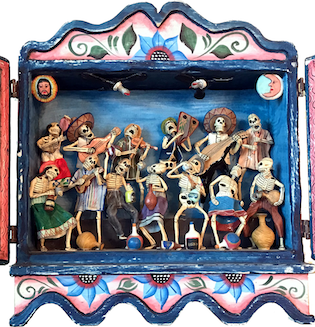
A retablo by Peruvian-American artist Nicario Jiménez.
Day of the Dead: Introduction
On the Day of the Dead (el Día de los Muertos), people in Mexico remember and honor relatives who have died. On this day, they decorate their homes with special home altars featuring playful imagery of human skeletons, and they leave offerings of food for the spirits of the dead. Also, the graves of deceased relatives are visited and cared for. The holiday has spread from Mexico to other places in the world.
The Day of the Dead is celebrated from the evening of October 31 through November 2. Legend has it that as October turns into November, spirits or souls of the dead can return briefly to earth, joining once again with their families for a short time. Specifically, children’s spirits are said to come back on the 1st of November, while the departed adults return on the 2nd. These spirits are also supposed to bring good luck.
The Cycle of Life and Death
This holiday is a festival, a time for families to be brought together. Filled with color, music, and food, the Day of the Dead is in many ways a celebration of life. It is a very old tradition, dating back thousands of years to the Aztecs. These ancient people thought of life and death as a cycle, like how the day turns into night and then to a new day. So they felt that both life and death should be honored.
But the holiday has certainly changed through the millennia. It was originally celebrated in the summer. As Catholicism grew in Mexico after the Spanish conquest, the Day of the Dead was switched to match the Catholic holidays of All Saints’ Day and All Souls’ Day, which are on November 1 and 2. Yet the Day of the Dead has remained largely the same—an enthusiastic celebration of life and death. Once celebrated just in southern Mexico, today the Day of the Dead is part of Mexican culture. In fact, many communities now observe this day all across Latin America, and extending to the United States and throughout the world!
Celebrate with Decorations
How do you celebrate this holiday?
First, with lots of decorations. These can range from wooden skulls (calaveras) with bells attached and paper skeletons (calacas) to emblems of a grinning skeleton, La Calavera Catrina. These calacas and calaveras are typically seen as lively, dancing around with festive colors ringed with flowers!
Central to all of this are the ofrendas. Ofrendas are detailed altars put up to commemorate those who have died. These altars can be covered with items, usually centering around the four elements — water, fire, earth, and air (or wind). These often include candles, flowers (especially marigolds), personal items, and photographs. Sometimes a family will make an ofrenda together to put in their home.
Celebrate with Food
Next, you’ll need plenty of food. With sugar skulls (calaveritas de azucar), special breads (pan de muerto), and traditional Mexican dishes, this is a feast for everyone. Sugar skulls are a delicious dessert made of sugar and colorful frosting–as well as whatever else you’d like to put on them, including creative hats! These crafted works of art are usually placed on the ofrendas… and then eaten afterwards!
Celebrate with Stories and Song
Stories, music, and dance are central to this holiday. Whether told, sung, or played by a mariachi band, the Day of the Dead is about remembering the past and one’s ancestors. So a visit to the cemetery is high up on the list, to tidy up and to give offerings. With music and food aplenty (as well as people galore) it can be a fiesta, especially with the processions around town.
The Day of the Dead can be both fun and meaningful—whatever you and your family wish. Whichever way, the holiday shows a healthy attitude towards death and the past that we can learn from.
